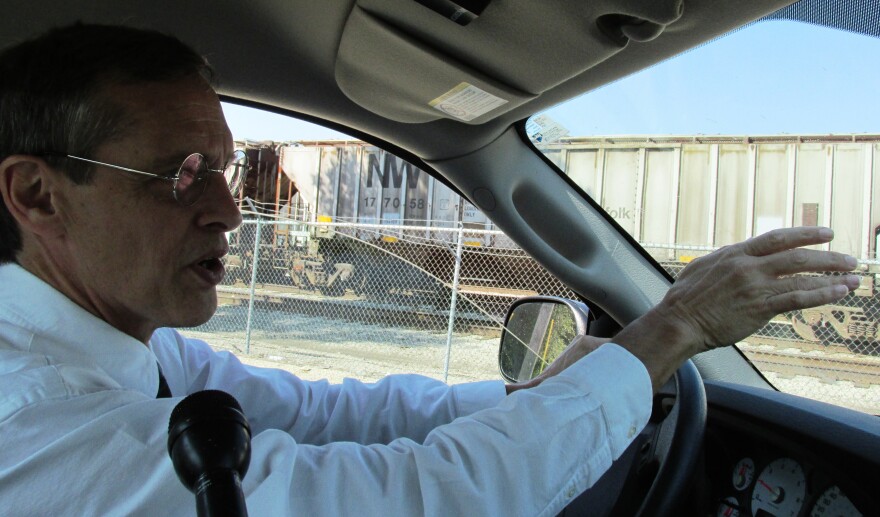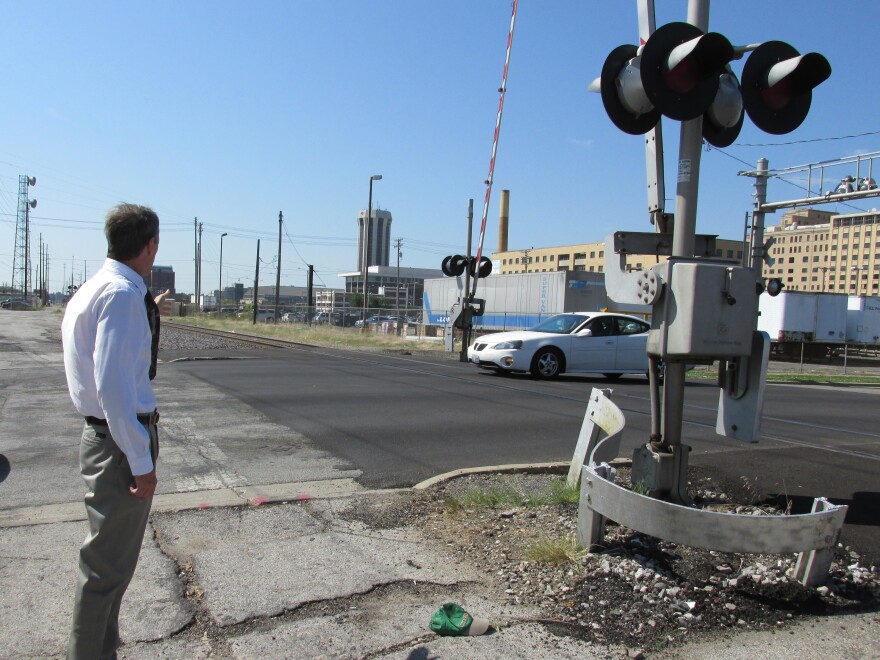The flow of traffic in Springfield could change dramatically in the coming decade.
Transportation planners seeking to re-route trains recently scored a major victory in the fight for funding.
The federal government announced August 30th a $14.4M grant to help pay for the first of several construction projects along 10th Street. Crews could begin work by summer 2014, but design work must be completed first.
Peter Gray introduces us to a man leading design efforts for the Springfield Rail Improvements Project, to learn more about his vision for the city's transportation future:
- AERIAL MAP of Springfield Rail Improvements Project (.pdf, zoom in for more detail)
- TIER II ENVIRONMENTAL IMPACT STUDY prepared by IDOT/USDOT (.pdf)
- 10TH STREET DESIGN REPORT prepared by Hanson Professional Services (.pdf)
Standing along Springfield’s 10th street rail corridor, I ask civil engineer Jim Moll to use his imagination. I want his blue-sky vision of this place in the not-too-distant future:
“The people of the city of Springfield hardly ever even notice the trains anymore. You don’t have to hear them, you really don’t see them, you don’t have to stop and wait for them… you’re not in danger of being hit by them. I think we’ve really taken this rail service through Springfield and made it as invisible and as unimpacting as possible.”
So why are we out here on a hot summer day, talking about the future of transportation in Springfield? Let me rewind:
I’m in the cab of Jim Moll’s cherry-red pickup truck. We’re driving east from his office at Hanson Professional Services to the site of his firm’s “Rail Improvements Project”.
Turning north off Laurel Street, Moll points out the window to a line of Norfolk Southern freight cars:

“The NS has a yard there now – there’s a rail yard there now. And we’re going to purchase that rail yard and they will relocate those operations and this in here will be where the four tracks are. And this street here will be closed and these residences along here will all be displaced.”
This street name itself – “10 1/2” - sounds like an afterthought of urban planning.
A lot of thought is being given to this neighborhood now - thought about wiping it off the map.
“…and this area from here over to that fence line, far fence line, will be the new corridor. And there will be two tracks in there for the Union Pacific, one track for the Norfolk Southern and room for the Norfolk Southern to have a future track. All of these – these businesses here – will be displaced.”
We pass a car repair shop, a towing service, a dozen or so small homes. Rail consolidation will mean this street, like many others, will cease to exist. I ask Jim Moll how residents have taken that news:
“We’ve talked to a number of people who will be displaced by the project. The overwhelming reaction is that they’d rather be bought out sooner rather than later. We have had a few people that really would rather stay where they’re at. But we’ve had a lot more people who are ready to move.”
117 homeowners and 53 business people will be offered fair market value for property in the planned railroad right-of-way, and the highest concentration of displacements will be next to planned underpasses. Moll says acquiring all that land isn’t just about creating a path for multiple train lines:

“Ambulance services, police and fire can plan on this as a route, where they don’t have to worry about getting stopped by a train.”
We're now at Carpenter Street, looking west at two hospital campuses.
We've stopped here for a few minutes because Moll says the rail consolidation effort starts here.
I look down at the sidewalk, trying to picture a 15-foot drop to a two-lane underpass below my feet.
“This crossing was the first chosen as the first part of the project to be built, because once we’ve got this built, then we’ve got an access point into the hospitals from areas to the east. Even if nothing else ever happens on the project. Even if there’s never any funding for anything else, this is a useful improvement for the city of Springfield.”
The federal government has just set aside $14.4M to put this piece of Moll’s rail improvement project in place. His firm this fall will wrap up design and engineering work on the Carpenter Street underpass so that construction can begin in 2014.
Part of the design calls for surveying and boring work. When I say boring, I mean that literally. Straight into the ground, down to the bedrock below...

"They did a series of about twenty borings, all along Carpenter Street here, from 9th to 11th Street, sampling the soil at various locations, so that we could develop a soil profile and to do our walls and structures.”
To some, this work may sound as dry as the ground we’re standing on. But to a civil engineer like Jim Moll, laying the groundwork for a massive re-route of train traffic is:
“…about as much fun as it gets. Having a project like this, where you start off with nobody really knowing anything, nobody knowing what the answer is. And they come to you and say ‘we need a solution to a problem.’ And you get to kind of come up with a solution and then work it all the way through until the solution gets implemented. This is the kind of project that makes engineering fun.”
In downtown Springfield, I’m Peter Gray.






